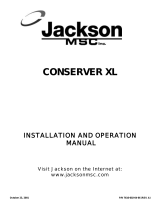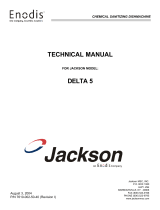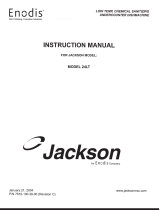
13
SECTION 2: INSTALLATION/OPERATION INSTRUCTIONS
CAM TIMER OPERATION FOR HT-2
The cam timer is a 2 minute 6 cam timer with an OFF-DRAIN function.
The following is a description of set points for each cam and function for each switch.
CAM 1: Cam 1 is a cut cam with a single notch and serves as the Cycle/Reset.
FUNCTION: When the machine is in the operation mode the notch is the home position. The machine will set idle until the door
is opened, then cam 1 moves to the start position and holds until the door is closed. The closing of the door will start the next
cycle. The cam will rotate a complete cycle and back to the home position and hold.
CAM 2: Cam 2 is a cut cam and provides the off/drain function.
FUNCTION: The function of the off/drain cam is controlled by the power switch. When the power switch is in the ON position
the off/drain function is disabled. To use the off/drain, start a cycle and place the power switch in the OFF position. The machine
will run a wash cycle, drain and stop. The machine will hold this state of operation until the power switch is turned on, when
turned on the machine will fill, run a rinse cycle and stop at the home position.
The off/drain cam works off the normally open contacts of cam 2. This requires the switch to be held closed by the cam. The
off/drain cam switch will pick up just after the cycle cam switch and drop back down just after the wash cycle cam switch.
CAM 3: Cam 3 is a cut cam and controls the wash and rinse cycles.
FUNCTION: The wash and rinse cam works off the normally open contacts of cam 3. This requires the switch to be held closed
by the cam. The wash/rinse cam switch will pick up just after the cycle cam switch and drop back down just before the off/drain
cycle cam switch. Wash pump will run approximately 58 seconds. The machine will drain and fill. The rinse cycle will start after
the fill, approximately at the 82 second mark and will last 35 seconds. The machine will then return to the home position.
NOTE: The last 3 cams are adjustable. The following instructions will require that the timer position have the cams to the front
and the motor to the left.
CAM 4: Cam 4 is an adjustable cam and controls the drain valve.
FUNCTION: The drain valve cam works off the normally closed contacts of cam 4. This requires the switch to be held open by
the cam and allowed to drop into the notch to operate the drain valve. The pumped drain and fill cams require adjustment due
to varying water pressure. The drain must be adjusted to remove whatever water the fill brings into the machine.
SETTINGS: The right side of cam 4 must be set to pick up the switch arm just before the wash cycle cam switch drops. If the
drain valve does not close first the water in the drain hose will back up into the pump housing and wash tank.
Any adjustment made to the drain should be made with the left side of cam 4. The adjustment must be moved back into the
wash time until all water is drained from the wash tank.
CAM 5: Cam 5 is an adjustable cam and controls the fill valve.
FUNCTION: The fill valve cam works off the normally closed contacts of cam 5. This requires the switch to be held open by the
cam and allowed to drop into the notch to operate the fill valve. The pumped drain and fill cams require adjustment due to vary-
ing water pressure. Cam 5 must be adjusted to fill the wash tank to the proper operating water level. (Remember, the drain
cycle must remove what the fill cycle brings in.)
SETTINGS: The left side of cam 5 must be set to drop in just past the stop point of the off/drain cam. There must be a dwell
between the off/drain and the fill, so that the fill will not run while the machine is in the off state.
Any adjustment made to the fill should be made with the right side of cam 5. Proper water level will be achieved when the water
touches the bottom of the strainer pan.
CAM 5: Cam 5 is an adjustable cam and also controls the rinse aid pump.



























